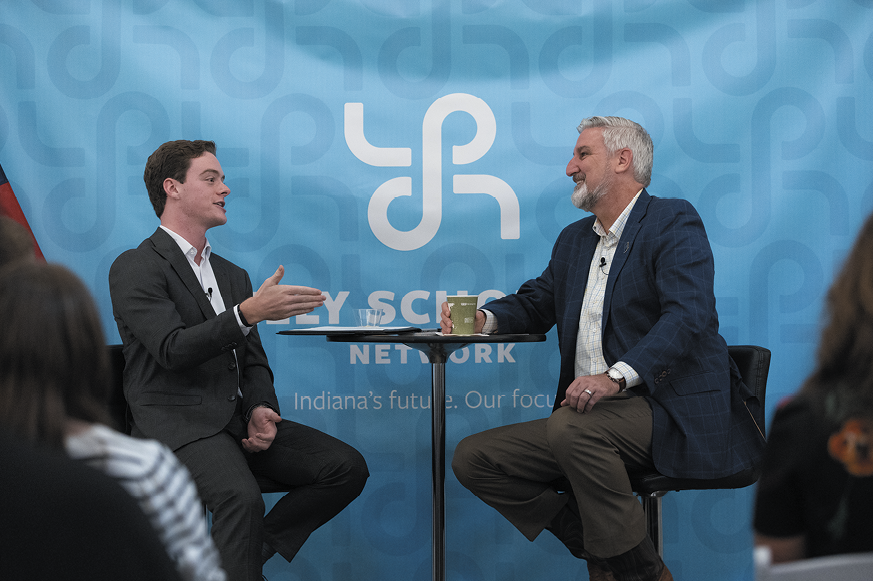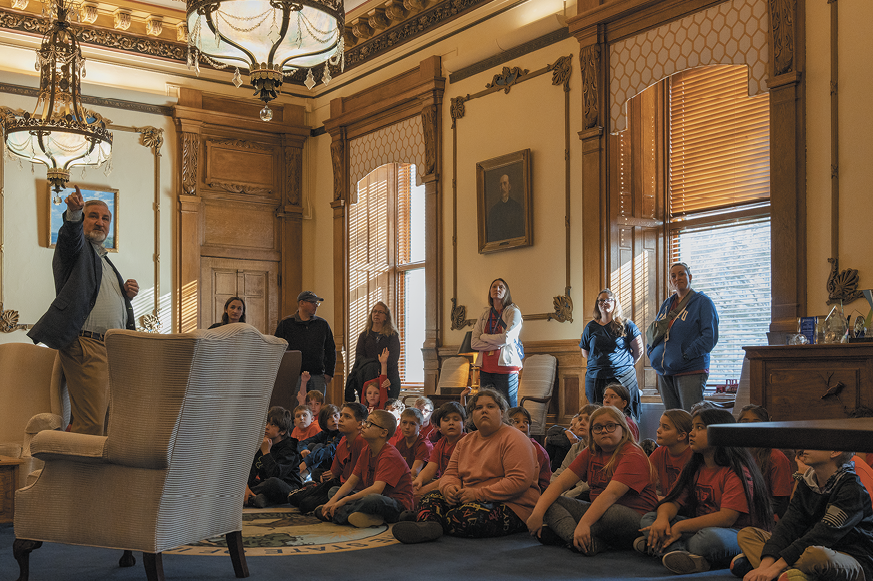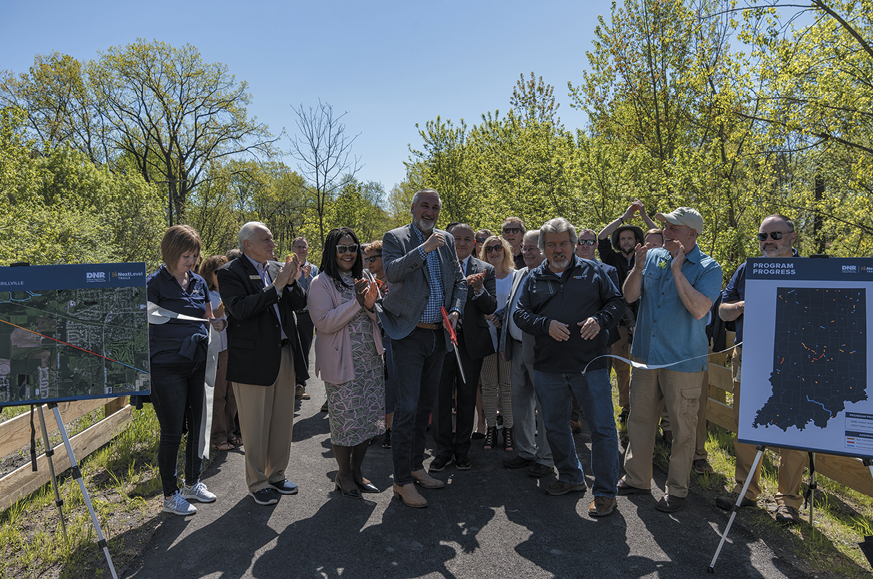- Home
- Media Kit
- MediaJet
- Current Issue
- Past Issues
- Ad Specs-Submission
- Reprints (PDF)
- Photo Specifications (PDF)
- Contact Us
- PRIVACY POLICY
- TERMS OF USE
![]()
ONLINE
![]()
ONLINE

The Crossroads
Of America
Editors’ Note
Eric Holcomb, 51st Governor of the State of Indiana, is a lifelong Hoosier who was born in Indianapolis, Indiana, and graduated from Pike High School in Indianapolis and Hanover College in southeastern Indiana. He went on to serve six years in the U.S. Navy, first at Naval Station Great Lakes and later in Florida and Portugal. Holcomb is currently serving in his second term as governor having been elected in 2016 and 2020 when he received the most votes for governor in Indiana history. Prior to his election as governor, Holcomb served as Indiana’s 51st Lieutenant Governor. A basketball fan and collector of presidential signatures, Holcomb has not only made a basket in each of Indiana’s 92 counties, but also possesses documents signed by every U.S. president. Holcomb serves on the Executive Committee of the National Governors Association and Republican Governors Association. In 2018, The Hill named him one of ten governors shaping the future of politics.

Governor Holcomb participates in a fireside chat with
Lilly Scholars discussing education in Indiana and
his time in public service
What attracted you to public service?
I’ve long felt strongly about contributing to something greater than myself and felt duty bound to serve my neighbors considering so many of them gave in unimaginable ways so that my family and yours could enjoy the freedoms to choose our own course. Whether it was volunteering in school and ultimately in the United States Navy, teamwork and focus on specific goals has been paramount to progress. From training at the Great Lakes Naval Station in Chicago, to being stationed at base in Florida and then again abroad at NATO War Headquarters Portugal, I will never forget the people I worked with and the lesson of adaptability in an ever-changing world that continue to shape my outlook on life and attitude towards tackling any problem thrown our way.
The common denominator in everything I’ve done to date professionally is service oriented. In the years that followed my military service, I worked for several government officials including a Congressman, U.S. Senator, and Governor, all of them who carried traits true to themselves. I learned through observance and hard work what it takes to be devoted to the betterment of Hoosiers and to make the necessary, often tough decisions for the greater good.
Will you provide an overview of the priorities for your administration?
My administration has been driven by five key pillars throughout the last eight years, called our “Next Level” agenda. These pillars generally include economic development; workforce development, including health, wellness and education; community development; and good government. My administration has never wavered in our efforts to drive positive changes to strengthen these pillars, and I intend to run through the finish line sprinting in full stride.
These five pillars require one another – they are building blocks to ensuring a better life for every person that seeks upward social mobility and calls Indiana home. For example, a skilled up workforce starts with ensuring our students have the tools to succeed with a quality education, K-12 and all the way through higher education or a trade to fully realize the American Dream. Indiana’s will be a future-focused economy with a plethora of career opportunities, a state that offers access to health improving resources and communities that support high quality of life, placemaking initiatives. Our assignment is all about leaving Indiana better than when we found it, and setting Hoosiers up for success wherever they steer and life leads them.

Governor Holcomb breaks ground in Princeton, Indiana
for the Toyota Indiana YMCA, a project funded by READI
Will you highlight your administration’s efforts to improve education in Indiana and reform K-12 education?
Our state has long been known for our high-quality schools, primary and post-primary, and for working to improve on those that lag behind them. One thing that will always remain true – the importance of education as a driver to unlock a person’s potential and light their pathway to personal prosperity is foundational and becoming a lifelong commitment. There is nothing more important than preparing students to succeed in whatever career path they choose, and it’s something I have made a priority from day one. Since 2017, Indiana has increased education funding by $1.8 billion, placing us among the top three states for the percentage of our budget devoted to public education. With this unprecedented commitment, teacher salaries will finally reach a statewide average of $60,000, and we were able to remove a hidden tax on parents by eliminating textbook and curriculum fees for more than 1 million students in traditional public and charter schools.
We also understand that we must provide resources for students that will help them to build confidence in the skills they are acquiring. We’ve established multiple vocational career pathways, shifted to teaching the science of reading, providing required access to computer science courses to underscore the importance of STEM education. Most importantly, we’ve set a high goal to ensure that by 2027, 95 percent of our Hoosier third graders demonstrate reading proficiency. When students learn to read, they can read to learn and unlock a whole new world of potential opportunities including serving in the military, going directly into a career at home, and/or attending Notre Dame, Purdue, Indiana University, or our statewide Community College.
How is your administration investing in infrastructure to strengthen Indiana’s connections between its communities?
Indiana is known as the “Crossroads of America” and backs it up by being the #1 ranked state in the nation for infrastructure by CNBC year over year. Infrastructure is the platform on which all industry and life rests upon.
For example, in the southwest quadrant of Indiana, our I-69 project from Evansville to Indianapolis is on track to be completed by the end of this year, three years ahead of schedule. Hoosier hands are building and connecting Indiana cities and towns along the entire route, and I couldn’t be more ecstatic about the new growth and prosperity that will come with it. In northwest Indiana, the South Shore Line has become officially double tracked and operational. As the biggest investment in rail in Indiana history, train wait times have decreased and economic impact increased, as region rail projects are projected to attract $2.7 billion in private investment to northwest Indiana.
Finally, our Community Crossings initiative has been a model hand-in-glove partnership that strengthens connections between our rural, urban and suburban communities in all 92 counties. It embraces the bottom-up approach, where local communities determine the need for infrastructure projects, and the state provides the funds to improve the safety and efficiency of our local roadways. Since 2016, communities have received $1.7 billion through this program. Communities large and small are building the infrastructure and Community Crossings is the key building block to building up high quality of place and life.

Governor Holcomb speaks with students visiting
the Statehouse from Loper Elementary
Will you discuss your administration’s work to build transparency and integrity in government?
Transparency is king. I strive to be open with Hoosiers, so they understand the “why” behind the “what” and the data that drives our decisions. For instance, in the height of the pandemic, it became crystal clear how data needed to be the determining factor for the decisions being made day-to-day, hour-by-hour, and minute-by-minute during a globally unprecedented time. The Indiana Department of Health quickly created a data dashboard on their website and shared the daily need-to-know pieces of information, such as open ICU beds, COVID deaths, vaccinated Hoosiers, and the list goes on. These nuggets of information informed us of the decisions we were making in real time, and it was crucial that Hoosiers understood the why, even if they disagreed.
Across the country, including Indiana, we are facing other health stressors, like obesity and smoking rates, and as a government we felt it was our duty to become part of the solution. In 2023, we passed an historic, generationally changing piece of legislation that will transform our public health system. Prior to the 2023 legislation, the state gave our local public health districts $14 million in a two-year span in hopes of transforming the lives of Hoosiers that needed additional financial resources. After years of not moving the needle, last year the state agreed to set aside $225 million over a two-year period for counties who wanted to opt-in and use the additional funds for public health needs, such as programming and resources. There are a lot of thoughts and opinions regarding public health, so we wanted a partnership between the state and local government that was voluntary. It’s called Health First Indiana.
We had to build the state’s structural health network integrity over time by being transparent with local elected officials, public health departments, community stakeholders and the general assembly to get all 92 counties to agree with the concept. As of May, all counties from corner to corner of the state have opted in. Even some of the local officials who initially spoke out adamantly against the program are converted supporters. This is because we were driven by transparency. All parties involved, including the public, whether they agreed or not, had all the information at their fingertips. We turned our cards face up from day one because we believed in the program and the impact it will make for years to come.

Governor Holcomb cuts the ribbon on the 100th mile of trail
in Lake County supported by investments in Next Level Trails
How critical is a strong public-private partnership in Indiana and will you highlight your working relationship with the business community?
At a time when the Hoosier economy is on a roll, public and private partnerships have never been more paramount to our success. In Indiana, it’s truly a team effort across all sectors. We are there every step of the way, convening the whole ecosystem at the table, including government leaders, academia, industry partners and other key stakeholders. The numbers speak for themselves – Indiana has been ranked the #1 place to start a business in 2023 – our committed capital investments are shattering records every quarter. The key to this success has been having open-door discussions on how we all can move forward and innovate together.
We can measure the true impact of public and private cooperation beyond economic metrics. Through regional development efforts, we are transforming communities and making Indiana a more attractive place to live, work, play and stay. In 2021 and then in 2023 the General Assembly passed legislation allocating $500 million from each biennium budget for the Regional Economic Acceleration & Development Initiative (READI) grant program. READI has become a nationally recognized innovative program that connects communities to build sustainable partnerships for growth, and hinges on local public, private, and philanthropic match funding. READI 1.0 has resulted in more than $12.6 billion invested in quality of place and quality of life assets. Community foundations and organizations have a working knowledge that’s proven to be instrumental to my administration. For example, in partnership with the Lilly Endowment, we were able to inject an additional $250 million to support the $500 million allocated for our READI 2.0 projects, focused on blight reduction, redevelopment, and arts and cultural projects. This endowment was the largest investment in their 86-year history. Together we know that to attract the businesses and talent we want, we must ensure the Hoosier state remains a place where people want to live, work, study, and stay. I’m grateful for partners who also want to see this vision through.
As you look to attract new industries and businesses to Indiana, how do you define the Indiana advantage?
Our advantage is the diversity of our economy and the tenacity with which we work to build business relationships. We have it all, from manufacturing, life sciences, agriculture, and even R&D in AI, semiconductors, energy development, and so much more. Just last year we were one of three states that were awarded three major federal hub partnerships – including a clean hydrogen hub, a microelectronics hub, and biotech manufacturing hub, all of which will bring even more investment and thousands of jobs, putting Indiana at the forefront of tech innovation. We’re strategically leaning into our strengths, proving Indiana is the destination to do and grow business.
Our strong foundation for companies to start and expand their business offers a long-term approach including a high sense of certainty, stability, predictability, and continuity. This fact alone makes us stand out among many other states bolstered by our initiative to meet companies where they are and telling the Indiana success story.
Since 2022, Indiana has brought in over $70 billion in committed capital investment through our Indiana Economic Development Corporation. Those investments are going to 25 counties around the state, bringing high-quality careers, with average salaries north of the local, state, and national average wages. What I think makes our Hoosier method even more unique is the constant commitment to taking our story globally.
Seventy-one percent of our over $28 billion in committed capital investment in 2023 was from foreign direct investment. In a time when global investment and trade are in question, and when isolationism is on too many tables, Indiana demonstrates how vitally important these resource flows and relationships can be. We’re modeling it for everyone to see the power of connections across the globe, and it is something I take an immense amount of pride in.
With so much gridlock and partisanship in Washington, DC, what do you see as the key ingredients in getting action and achieving results?
America will not overcome any critical issues until our elected officials set aside their microphones and social media feeds long enough to set priorities, make serious plans, and figure out how to pass productive laws. I believe that most people really do want to listen to each other and have thoughtful discussions rather than yell across hopeless divides, because in the end we all want what is best for our state and nation and hope our voices will carry the days ahead.
As government officials, we’re all elected to fulfill the promises we made, not merely get paid to talk about them. I can only encourage my fellow public servants to make good on those promises, create plans and stick to them, always open to the collaboration that can move the ball down the field. At the end of the day, we should never lose sight of the reason one serves. It’s an absolute privilege for me to go to work every day, knowing how decisions made today are ultimately going to make a Hoosier’s life better. Take a look at the big picture and never lose sight of that mission, then grade yourself on progress made on your watch.
With the success that your administration has achieved for Indiana, are you able to enjoy the process and take moments to celebrate the wins?
I try to encourage others to smell the roses along the way. We should take pride in our progress, but I balance the wins with the work left to be done. Hoosiers can count on me to work for them until my last hour on the last day of my second term. I hope I’ve shown that we Hoosiers aren’t afraid of the future, but are determined to define it.
Serving as governor has been the opportunity of a lifetime, creating programs and projects that will have an immense return on investment for Hoosiers in the 5, 10, 20 years ahead.![]()